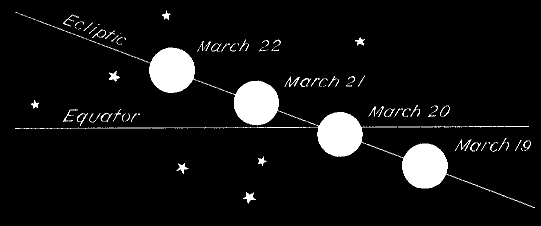 |
 |
There are two ways of finding how long it takes the sun to complete its apparent revolution in the heavens, or, in other words, how long it takes the earth to make a complete revolution around it.
One of these consists in observing the exact time at which the sun reaches the equinoxes. In ancient times astronomical observers were able to do this by noting the days when the sun rose exactly in the east or set exactly in the west. By observing the rising and setting from day to day, they could find not only the day, but almost the hour in which the sun was on the celestial equator. Of course, with our more exact instruments we can get this time with still greater precision.
The period between two returns of the sun to the same equinox is called the solar year or equinoxial year.
The other way of finding the length of the year consists in observing the interval of time between two passages of the sun past the same star in the heavens; for example, the period between two of its passages past one of the stars shown in figure 20.
This method seems to involve the great difficulty that we cannot see when the sun is near the star. But the astronomer has methods of knowing exactly where a star is by day as well as by night, and can determine the moment at which the sun passes it.
The ancient astronomers got the same result by using the moon as an intermediate object to measure from. The moon could be seen before sunset and its distance from the sun determined. Then, when the star appeared after sunset, the distance from the star to the moon was measured. Allowing for the motion of the moon during the interval, the apparent distance between the sun and the star could thus be learned from day to day. In this way it could be found how many days it was between the times at which the sun was at the same distance from any given bright star. This would be the period of apparent revolution of the sun in the celestial sphere, or, as we now know it to be, the period of one revolution of the earth in its orbit. This period is called the sidereal year, because it is fixed by the stars.
Hipparchus, who flourished about 150 B.C., was the first to take exact observations of the length of the year. Ptolemy, who flourished about 300 years later, made similar ones. They found that the length of the year, as determined in these two ways, was not the same, and that the solar year, as determined by the equinoxes, was several minutes shorter than the sidereal year determined by the return of the sun to the same star.
With our exact modern observations we have found the lengths of the years to be:--
| Solar year, | 365 | d. | 5 | h. | 48 | m. | 46 | s. |
| Sidereal year, | 365 | 6 | 9 | 9 | ||||
|
|
||||||||
| Difference, | 20 | m. | 23 | s. | ||||
This difference shows that the position of the equinoxes among the stars is changing from year to year. Hipparchus and Ptolemy estimated the change to be about one degree in a century. We know it to be greater than this, -- nearly one degree in 70 years.